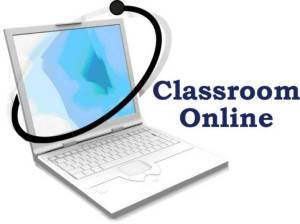E-Learning is the use of technology to enable people to learn anytime and anywhere. E-Learning can include training, the delivery of just-in-time information and guidance from experts.
E-learning refers to the use of technology in learning and education. There are several aspects to describing the intellectual and technical development of e-learning, which can be categorized into discrete areas.
- e-learning as an educational approach or tool that supports traditional subjects;
- e-learning as a technological medium that assists in the communication of knowledge, and its development and exchange;
- e-learning itself as an educational subject; such courses may be called “Computer Studies” or “Information and Communication Technology (ICT)”;
- E-learning administrative tools such as education management information systems (EMIS).
E-learning can be better understood by having a detailed knowledge about its various facets like: synchronous (involves the exchange of ideas and information with one or more participants during the same period of time. A face-to-face discussion is an example of synchronous communications) and asynchronous (may use technologies such as email, blogs, wikis, and discussion boards, as well as web-supported textbooks, hypertext documents, audio video courses, and social networking using web 2.0. At the professional educational level, training may include virtual operating rooms. Asynchronous learning is particularly beneficial for students who have health problems or have child care responsibilities and regularly leaving the home to attend lectures is difficult). Linear learning and collaborative learning are other aspects involved.
If, one could stop time and inexpensively bring together all of the people under an organization, who need to learn and have the resources to teach them, one would not need e-learning. But, in the real world, people have jobs to do and budgets are limited. The learning program will need the power of technology to overcome the limitations of time, distance and resources. E-learning then comes as a savior.
If you are a college student or if you are an adult who simply wants to become better educated, it’s a good time to take stock and to think about what you may need to do to be ready to jump into the virtual world of online learning.
Online opportunities for learning and for earning college degrees have become pervasive in the last 10 years. Most two- and four-year colleges now offer online options. For-profit colleges that exist solely online now offer both undergraduate and graduate degrees.
Degree, non-degree oriented courses being offered by universities worldwide through the internet for people who simply want to learn new things, e-learning becomes a sea of change in education.
And yet…only 50 percent of students who register for online classes succeed. (This is compared to an average of 70 percent of students in traditional campus classes.) It’s not because those who fail aren’t smart. It’s not because they don’t have good intentions. Research has identified factors that have more to do with a student’s psychology than intelligence.
If you are considering taking online courses and want to be in the 50 percent who make it through (and with good grades), here are at least some of the variables that make a difference:
Be realistic about what you are taking on.
There seems to be a myth among at least some students that online classes are easier than campus classes. Generally they aren’t. You are signing on to wrestle with new material, to master new skills, or to increase your own knowledge base. A good online class will be as challenging as any course you’ve taken in a brick building.
Be realistic about your reality.
Most online students are adults with adult lives. That means families, jobs, and complicated schedules. Be sure you really have the time and energy to put eight to 10 hours a week into reading, researching and responding.
Whatever your good intentions and optimism, there are only so many hours in a day and you only have so much energy. Before writing the check to take a class, be sure you can fit it into your schedule.
Be realistic about your own motivation and maturity.
Online learning requires that you “show up” and show up regularly. Often you will be responsible for making submissions that other students need in order to keep a discussion going. Since there is no set time to participate in class, it’s easy to let a day or two or four go by because of other obligations. That’s a setup for failure.
More than a few of the e-learning students fall out by the wayside due to major issues with procrastination. If you procrastinate and get behind, it becomes harder and harder to get caught up. If you are irresponsible about doing your share of group work or getting assignments done on time, you risk alienating your classmates and annoying your teacher, who doesn’t have the time or the responsibility to chase you.
Be realistic about your time management skills.
Succeeding online means logging in every day or at least 5 days a week. It means doing the reading so you can do the assessments and assignments. It means taking the time to participate in the class discussions. Students in e-learning classes who succeed treat the online course very much like a part-time job. They set aside regular, predictable time to do the work. They keep a calendar to make sure they meet deadlines and immediately do makeup work if they had to be “absent” for a day.
Be realistic about your willingness to engage with others.
Ironically, your professor and classmates will get to know you online at least as well, and often better, than if you were sitting together in class. Campus students can be virtually invisible by not volunteering in class. Online learning requires that you be out there, visible and engaged. Success comes to those who post regularly, who show that they have thought hard about the readings, and who contribute novel and interesting ideas to discussions.
Success also comes from encouraging others, from asking good questions, and from being willing to be challenged. When people engage in discussions without attacking others and without being defensive about their own contributions, discussions can be very rich and meaningful.
Be realistic about your skill with words.
For now, at least, online learning generally requires communicating well in writing. “Discussions” are all by posts. Group work is through written chats within the class. Your words represent you. Poor grammar, spelling mistakes, rambling prose, or confusing paragraphs will get in the way of success, no matter how good your ideas may be. Teachers and peers don’t have the energy and patience to decipher your meaning. If you aren’t confident about your ability to communicate well in writing, it would be wise to get a tutor to help you hone your skills before tackling a course online. Another option is to first take an online course in expository writing.
Be realistic about your skill on a computer.
If you aren’t a reasonably competent typist, if you don’t know your way around Word or have difficulty learning how to navigate a platform, you’ll quickly become frustrated with the whole enterprise. Frustrated people tend to get anxious and annoyed. Often they fall behind and then get so discouraged they drop out.
It’s a new world. I fully expect that the boundaries between campus and online learning will continue to blur as an inevitable outcome of technological advances. The best online students are those who find it exciting to be on the cutting edge of change and who engage in class with curiosity and enthusiasm.


